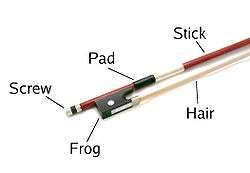Down bow


A down-bow is a type of stroke used when bowing a musical instrument, most often a string instrument. The player performs the indicated note by drawing the bow downward or to the right across the instrument, moving its point of contact from the frog toward the tip of the bow. This technique is indicated by a notated symbol resembling a small bracket over the note.[1]
Instruments
How the down-bow is achieved varies depending on the shape and orientation of the instrument.
| Instrument | How the player achieves the down-bow |
|---|---|
| Violin | The player pulls the bow down, away from the left shoulder |
| Viola | The player pulls the bow down, away from the left shoulder |
| Cello | The player pulls the bow to the right, away from the left elbow |
| Double bass | The player pulls the bow to the right, away from the left elbow |
Uses
String players can exert stronger pressure when bowing near the frog than when bowing near the tip, due to the bowing hand's proximity to the bow's contact point with the string. Down-bows, which begin near the frog, are therefore often used to play the downbeat (strong beat) within musical phrases. Notes that begin loudly and diminuendo are ideally down-bowed — from frog to tip — allowing pressure on the string to decrease naturally.
